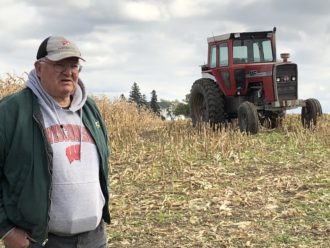In southeast Wisconsin, Dan Stoffel grows soybeans, alfalfa, and oats on 800 acres of rolling terrain that’s been in his family since the late 1870s. Stoffel’s no stranger to conservation and sustainability. His farm’s unique landscape, carved by various glaciation periods from 75,000 to 11,000 years ago, has lent itself to practices like contour cropping and no-till, put in place by his grandfather back in the 1930s. So when a conservation group brought up the idea of prairie strip plantings, Stoffel was open-minded.
Prairie strip plantings are strips of native perennial vegetation strategically planted within a farm field to hold soil, nutrients, and rainfall while also providing habitat for helpful pollinators. Previous SARE-funded research at Iowa State University has demonstrated benefits associated with prairie strips such as improved water quality and phosphorus and sediment loss reduction with minimal impact on crop production.
On Stoffel’s farm, two fields in particular had some problematic water flow areas. Conservation-minded experts at Sand County Foundation proposed prairie strips that would run perpendicular to the slope to reduce water flow.
Based in Wisconsin, Sand County Foundation works with private landowners to use sustainable land management practices. With a $197,678 Research and Education grant from NCR-SARE, Sand County Foundation received support to extend and adapt the experience of Iowa State University prairie strips project into Wisconsin.
“Initially, I wanted to just get a sense how they look and how they work,” said Stoffel in a 2018 interview with Sand County Foundation. “Two years into this I’ve found their root structures and plant residue really make a big difference. They really hold their own against the water.”
Benefits of Prairie Strips
But improving water quality and reducing runoff isn’t the only benefit of prairie filter strips. They also provide food and habitat for pollinators, beneficial insects, and other wildlife, which Stoffel also appreciated.
“As a beekeeper, I was surprised at the number of (beneficial) insects these narrow strips of diversity attract amid a monoculture,” said Stoffel. “I can’t go three plants without seeing a native insect. It was amazing for just being established for two years.”
Stoffel’s positive experience with prairie strips is not unique. Sand County Foundation alone has provided direct assistance with prairie strips to seven farmers in total, with another three farmers who are interested as well. The goal is to fit prairie strips conveniently within a farm’s existing annual row crop operations.
“I like how the practice strives to be compatible with existing systems, fitting with current crops and farming equipment,” said Sand County Foundation program director, Craig Ficenec. “ And yet it’s a little bit radical, converting just a fraction of cropland back to prairie. And most of all, done right it’s effective and potentially a less costly way to protect water quality compared to some of the traditional structural practices. And it provides wildlife habitat at the same time. Farmers who convert strategically selected areas of annually cropped ground to permanent and diverse vegetative cover can potentially meet rising expectations for water quality protection with minimal impacts on farm profitability.”
Dig Deeper
Sand County Foundation and early prairie strip adopters like Dan Stoffel are sharing stories and information about prairie strips with other farmers through publications, field days, workshops, and presentations at conferences.
- The Soil Nutrient Application Planner (SnapPlus) is a software tool used on farms across Wisconsin to calculate soil and phosphorus (P) runoff losses on a field-by-field basis. Sand County Foundation and the University of Wisconsin are using SnapPlus to compare sediment and P losses from Wisconsin farms with and without prairie strips. Read more about it:
https://projects.sare.org/media/pdf/S/C/F/SCF-Strips-SnapPlus-WEB.pdf - Read a 2-page Sand County Foundation’s Conservation Brief about Prairie Strips: https://www.sandcountyfoundation.org/uploads/publications/SCF-Prairie-Strips-2-Pager-WEB.pdf
- Watch videos of Dan Stoffel and other farmers in the field talking about their prairie strip plantings at www.sandcountyfoundation.org/prairiestrips.
View Related SARE Grants:
- Advancing cost effective water quality improvement in the North Central Region through farmer-led engagement for prairie filter strips (LNC16-378)
- Mixing Reconstructed Prairie with Cropland to Balance Food and Biofuel Production with Environmental Quality (LNC09-314)
